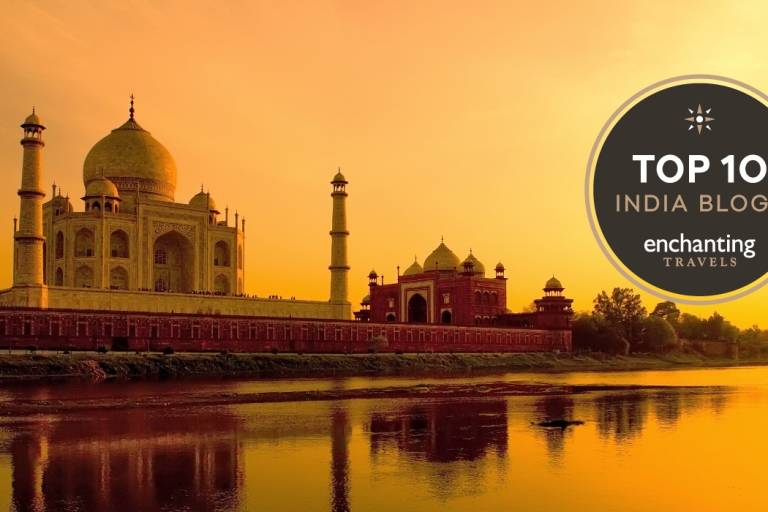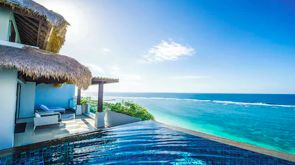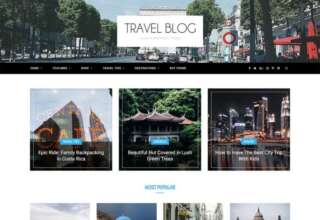A vibrant, walkable city, Sarajevo is thriving thanks, in part, to its contemporary culture and art, which is on display at galleries … and also its restaurants, bars and hotels

On a warm summer day, I strolled down Wilson Alley, a promenade lined with shady linden trees in the centre of Sarajevo, the calm Miljacka river on one side and stylish cafes with alfresco dining on the other. I joined a cluster of people staring down at a scaly crocodile crawling from a gaping crack in the pavement, one of myriad pieces of 3D chalk art splashed across Sarajevo’s concrete streets during the Beton Fest. During this free event, held each August for the past four years, I witnessed artists creating wonderful pieces, including a sword impaled in a rock beside a helmet – referencing Excalibur but also symbolising 20 years since the Bosnian peace agreement. With salsa dancing in the streets, 3D art workshops, and notable European street artists in attendance, it’s hard to imagine this city was once under siege.
Many locals, especially the young, are anxious to move forward. “The Sarajevo youth want a more a modern city,” says Adis Nović, journalist and the new director of Beton Fest. Maybe because of its history and the continued ethnic political disputes, a resilient, entrepreneurial spirit flourishes. And that new optimism is palpable, with money from foreign investors and governments trickling in, and Bosnia recently applying for EU membership. “These changes give us an opportunity to portray our culture, expand our horizons and improve our living standards,” says Nović.
Cafe Gallery Zvono
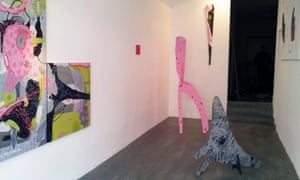
Down an alley beside the Fine Arts Academy, this cafe-gallery offers a chance to mingle with Sarajevan artists exhibiting their work, or to take in a film screening or literary event. Founded in 1979 as a creative space, Zvono moved to this location 18 months ago. The spare, whitewashed interior decorated with vinyl records attracts journalists, musicians and artists who sometimes just pop in for a Bosnian brandy or beer. The gallery often displays solo exhibitions, recently showing the ethereal inks on handmade paper of South Korean artist Eun Soo Lim.
•Obala Maka Dizdara 10,on Facebook
Pink Houdini
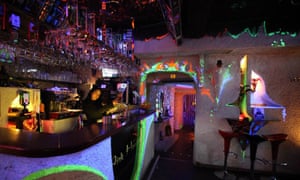
The crowd is largely young and single but music lovers of all ages are known to drop by Pink Houdini, an underground jazz and blues club with a kitschy, futuristic neon aesthetic. Pink is the dominant colour in this 24-7 space that is a coffee shop by day – and the word “Houdini” is a motif, since owner Mensur Hodzic believes anything is possible here. His string and wind instruments hang from the ceiling in one of the warren of rooms, and are used by students during jam nights when notables, such as drummer, Didi Jankelic, might show up.
•Branilaca Sarajeva 31, +387 63 895 195, on Facebook
Dekanter
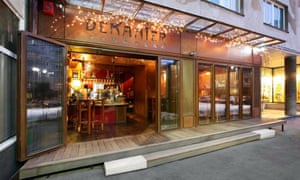
A grassy terrace with fairy lights makes for a bucolic setting at the city’s most sophisticated, but informal, wine bar. Sip a citrusy Kozlovic Malvazija while snuggled on the cushioned steps fronting the terrace. The wine list focuses mostly on Balkans varieties, especially Bosnia and Herzegovina. In the cosy interior, chopping boards and other paraphernalia dangle overhead, and patrons are encouraged to contribute graffiti to a chalkboard wall. Arrive early before the crowds of urban professionals settle in.
• Radićeva 4, +387 33 263 815
Gallery Boris Smoje

Groups of students, linger over iced cappuccinos and gather at umbrella-shaded tables in the pleasant outdoor terrace space. Inside, an ever-changing array of photographs, sculptures, oils and acrylics is exhibited. Saturday nights bring live music, which may include experimental electronica or new school Bosnian folk (sevdah) tunes.
•Radićeva 11, on Facebook
President Hotel
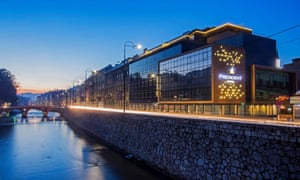
The modern 72-room President Hotel opened just over six months ago in the centre of the old town. The most coveted rooms are the immense deluxe doubles with large balconies offering grand views of the Miljacka river or the 15th-century silk bazaar, Baščaršija, now a museum in the old town. Large photo murals over the bed display the city’s past and present signature sights, including the 19th-century Sacred Heart Cathedral and the Festina Lente bridge.
•Doubles from £79, Bazardžani 1, +387 33 575 000, hotelpresident.ba
Café de Paris

Bosnian-born Adi Kadric spent most of his life in France but returned, bringing a bit of Paris with him, in the form of this one-year-old cafe-bar. The light-filled, riverfront space offers a peaceful, smoke-free experience – a treat in Sarajevo where smoking is de rigueur – that melds Kadric’s mixed traditions, serving local fruit juices and wines along with croissants, 20 different French cheeses, and glasses of Côtes du Rhône and bordeaux. In good weather, patrons head for the outdoor patio where they can sip La Parisienne, a refreshing homemade brew with coriander and orange skins.
• Hamdije Kresevljakovica 61, on Facebook
Klopa

Just off the frenetic Ferhadija, the main pedestrian street, Klopa is a welcoming space bedecked with colourful polka dot kitchen pots. Plants draped on the walls act as vertical gardens, and everything from chandeliers to banquettes is constructed from different local woods. Most of the food is prepared in a woodburning oven, including the buns for the veal burger, Klopa’s signature dish. Klopa is one of the few Sarajevan restaurants offering a variety of vegetarian meals, such as the vegetarian pot, a baked dish made with half a dozen different seasonal veggies plus white wine and salsa sauce.
•Mains from €3, Ferhadija 5, +387 33 223 633, on Facebook
Superfood
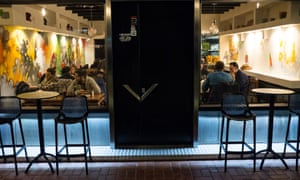
Chef and owner Adriatik “Ticky” Kući has created a vibrant oasis at his recently opened Superfood – with its street art-inspired murals. Guests come for the organic, international menu, plus live jazz, blues and pop music on Monday nights. The Moroccan lamb burger drizzled with mustard seed sauce is a big hit. So is breakfast – the best in the city – featuring the true blue: poached eggs in Gorgonzola sauce. Other popular and innovative breakfast dishes include avocado deviled eggs, and eggs poached in pumpkin butter sauce.
• Mains from €5, breakfast from €3, Husrefa Redzica 14, +387 33 977 797, on Facebook
Colors Inn Sarajevo
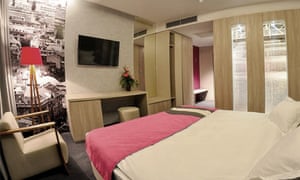
At the contemporary Colors Inn Sarajevo, the designers have embraced a nature-based theme in the basement-level breakfast room, with photomurals of white birch trees line the walls and fallen tree trunks arranged in planter beds. The breakfast buffet is extensive: myriad local hams and sausages, and cow’s milk and Trappist cheeses. Guest corridors are almost a museum, with photos of iconic city structures, such as the recently reopened City Hall. Within the 37 spacious guest rooms, accents come in a variety of colours – hence the boutique hotel’s name – but they also serve to references the city’s multicultural spirit.
• Rooms from £65, Koševo 8, +387 33 276 600, hotelcolorsinnsarajevo.com
Ars Aevi Art Depot
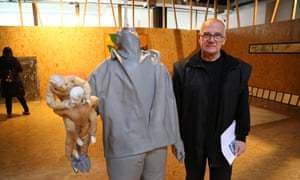
South-east Europe’s greatest collection of international contemporary art is in a highly unconventional, two-floor space resembling a wooden crate. Ars Aevi Art Depot is the newly opened – but temporary – home of more than 200 photographs, paintings, sculptures, video installations contributed by celebrated artists from around the world, such as Michelangelo Pistoletto. Conceived during the war as an example of international cultural co-operation, the depot became a reality thanks to a grant from the Italian government. It awaits its much disputed permanent home – designed gratis by renowned architect, Renzo Piano – that will set the stage for a museum quarter, along with the just reopened National Museum and the Historical Museum. “The future museum will support political, cultural and economic healing for Sarajevo,” says executive director Amila Ramović.


